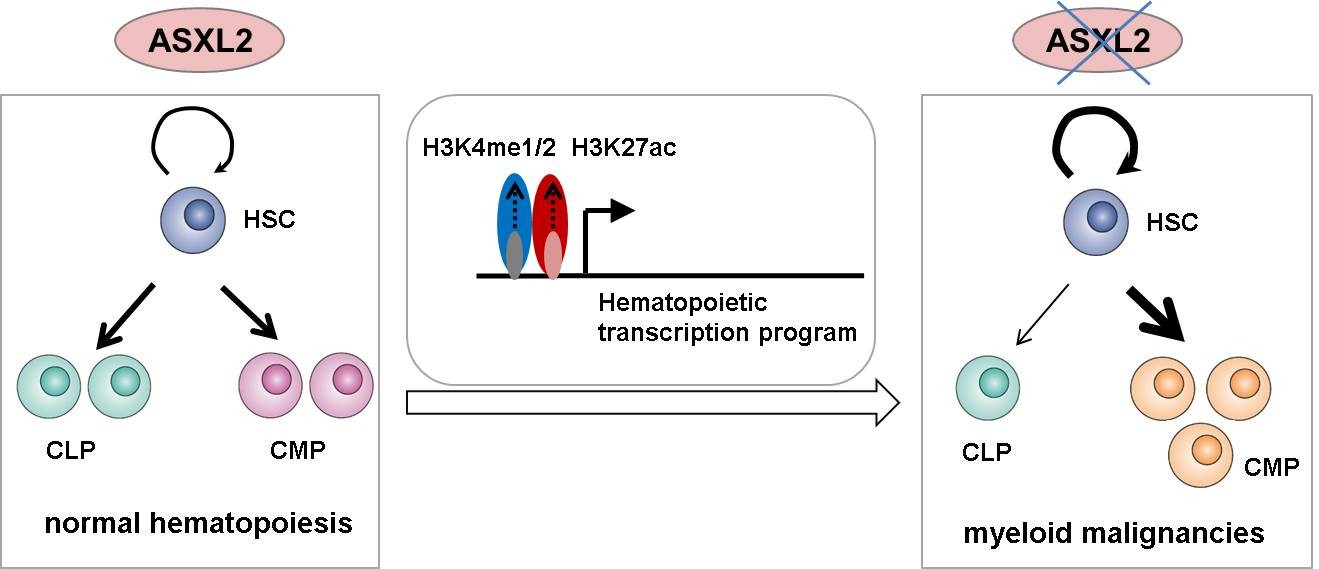New Study Reveals a Critical Role of ASXL2 in Maintenance of Normal HSC Functions and Suppression of Myeloid Malignancies
A new research published in Nature Communications reported that loss of Asxl2 alters self-renewal and cell fate of hematopoietic stem cells (HSCs), leading to myelodysplastic syndrome-like disease in mice. The study, conducted by Dr. WANG Qianfei from Beijing Institute of Genomics, Chinese Academy of Sciences, and Drs. YANG Fengchun and XU Mingjiang from University of Miami Miller School of Medicine, revealed a pivotal role of ASXL2 in the maintenance of normal HSC functions.
Hematopoietic stem cells (HSCs) are the stem cells that give rise to all lineages of blood cells. The balance between HSC self-renewal and lineage specification is governed by the interplay between multiple stimuli including epigenetic factors.
Epigenetic alterations play a critical role in myeloid malignancies by establishing specific gene expression profiles. ASXL2, as a putative Polycomb protein, is frequently mutated in myeloid malignancies and associates with higher cumulative incidence of relapse.
To investigate the role of ASXL2 in normal and malignant hematopoiesis, scientists utilized an Asxl2-knockout murine model to determine disease phenotypes of Asxl1 loss and effects on histone modifications and transcriptome.
They found that Asxl2 loss led to a myelodysplastic syndrome (MDS)-like disease in mice as evidenced by pancytopenia, dysplastic features of myeloid cells and skewed differentiation towards myeloid lineages.
Asxl2-/- mice displayed increased frequency of long-term (LT) HSCs. Bone marrow (BM) cells from Asxl2-/- or Asxl2+/- mice induced a leukemic transformation in the lethally irradiated recipients, indicating a cell-autonomous effect of Asxl2 loss on the pathogenesis of myeloid malignancies.
RNA-seq and bioinformatics analyses identified aberrantly expressed genes in BM Lin-cKit+ (LK) cells from Asxl2-/- mice, which were associated with HSC function, cell apoptosis, and myelopoiesis.
Integration analysis of RNA-seq and ChIP-seq showed that H3K27ac and H3K4me1/2, which are associated with active transcription, were changed at specific genomic loci in Asxl2-/- LK cells.
Importantly, the altered gene expression was associated with these dysregulated histone marks. Altogether, these data demonstrated ASXL2 regulates hematopoietic transcriptional program through histone modifications, to maintain normal HSC functions and suppress myeloid malignancies.
Recent years, cancer genomics studies have shown that pre-leukemic clones are required for the pathogenesis of hematopoietic malignancies. Somatic alterations in epigenetic regulators including ASXL2 are recurrent in patients with myeloid malignancies, including MDS and acute myeloid leukemia. These somatic mutations are critical events in pre-leukemic clones.
This study unveils a pivotal role of ASXL2 in the maintenance of HSC functions and suppression of myeloid malignancies, providing great promise for early diagnosis and future treatment of cancers.
This work was supported in part by grants from the National Key Basic Research Program of China, the National Natural Science Foundation of China, and Chinese Academy of Sciences.

ASXL2, which is frequently mutated in myeloid malignancies, plays a tumor suppressor in the maintenance of HSC functions through histone modifications (Image by WANG Qianfei's group)